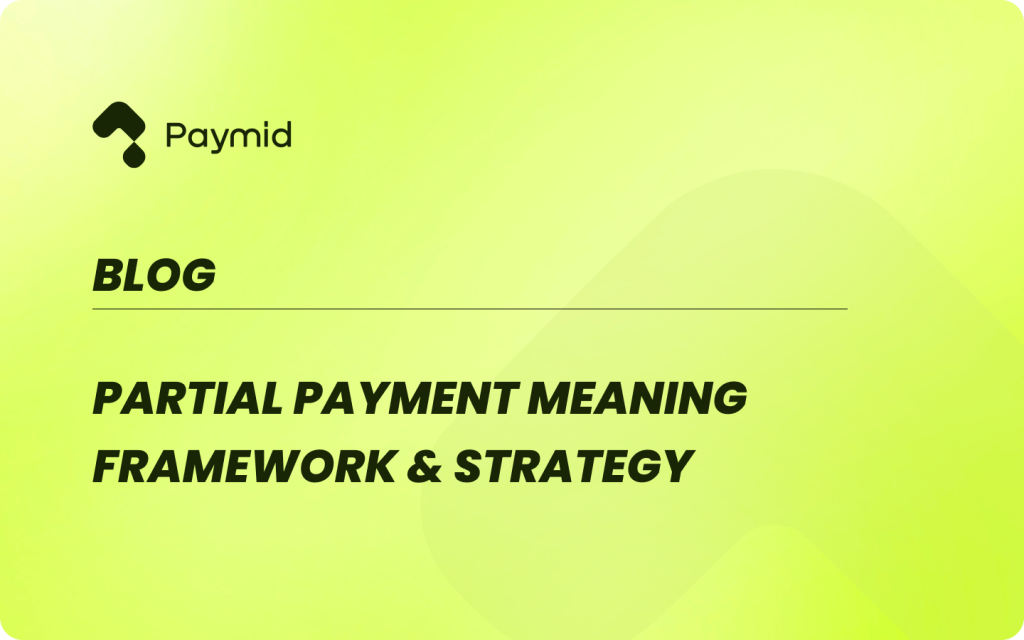Partial Payment Meaning: Framework, Compliance & Strategy

Managing business payments effectively can mean the difference between growth and stagnation. For many companies, understanding partial payment and implementing flexible payment options has become crucial for maintaining healthy cash flow and customer relationships. These payment arrangements allow customers to split their total payment into multiple installments, creating a win-win situation for both parties.
What is a partial payment, and why does it matter for modern businesses? A partial payment occurs when a customer pays less than the full amount due on an invoice or purchase, with an agreement to pay the remaining balance according to specified terms. This payment method has gained significant traction across industries, from retail to professional services, as businesses adapt to changing market demands and customer preferences[1].
⚡ Key Takeaways
- Partial payments offer customers manageable payment options, boosting customer satisfaction, sales, and competitive advantage for businesses.
- Structured payment systems improve cash flow through predictable schedules, reducing delays and outstanding payments.
- Effective credit assessment, default prevention, and compliance measures are essential for maintaining financial security in partial payment systems.
Read More:
- How to Write a Proof of Rent Payment Letter: Step by Step Guide
- How To Choose The Best iGaming Payment Solutions
- Credit Card Networks & Issuers Exploration for Beginners
- Top Tips for Managing Venmo Recurring Payments Efficiently
Understanding Partial Payments
Partial payment represents a fundamental concept in modern business transactions where customers pay less than the full amount due, with an agreement to settle the remaining balance according to specified terms. This payment method has evolved into a sophisticated financial arrangement that serves various business needs and customer preferences.
A partial payment occurs when a customer makes an installment payment that is less than the total amount due on an invoice. This arrangement typically involves creating a payment schedule between the billing party and the customer and establishing clear terms for settling the full amount[2]. The concept extends beyond simple split payments, encompassing various structured payment solutions that benefit both parties.
Types of Partial Payment Arrangements
Businesses implement several forms of partial payment structures:
- Service Orders: Initial payment upon order placement, with the remaining balance due upon completion.
- Installment Accounts: Fixed payments over time for large purchases.
- Revolving Accounts: Variable payments based on credit limits and usage.
- Real Estate Transactions: Down payments followed by mortgage arrangements.
Legal Framework and Regulations
The legal structure governing partial payments ensures protection for both businesses and customers. Creditors must accept partial payments under specific circumstances, particularly in cases involving foreclosure or collection processes[3]. Key regulatory aspects include:
- Payment application priority, where funds must first be applied to principal assessments before fees.
- Requirements for clear documentation of payment terms and schedules.
- Specific rules regarding payment acceptance during collection processes.
- Obligations for businesses to maintain transparent payment policies.
These frameworks establish standardized practices while providing flexibility for businesses to implement partial payment systems that align with their operational needs and customer requirements.
Benefits of Offering Partial Payments
Implementing partial payment options delivers substantial advantages for modern businesses seeking to optimize their operations and enhance their market position. Organizations that adopt flexible payment solutions experience multiple benefits across various operational aspects[4].
Improved Cash Flow Management
Businesses implementing partial payment systems experience enhanced cash flow stability through accelerated receivables. By accepting initial deposits and structured installments, companies can maintain steady revenue streams while reducing the impact of delayed payments. Organizations can effectively:
- Speed up accounts receivable through earlier invoice processing.
- Reduce the burden of outstanding payments.
- Improve financial forecasting with predictable payment schedules.
Enhanced Customer Satisfaction
The flexibility offered through partial payment arrangements significantly improves customer experience and loyalty. When businesses provide payment alternatives, they address diverse customer needs and financial situations. This approach leads to increased customer retention and positive brand perception, particularly when customers can manage their expenses more effectively through installment options[5].
Competitive Advantage in the Market
In today’s dynamic business environment, offering partial payment solutions creates a distinct market advantage. Companies implementing flexible payment options experience:
- Reduced cart abandonment rates.
- Higher average order values.
- Expanded customer base accessibility.
The implementation of partial payment systems particularly benefits e-commerce operations, where payment flexibility can significantly impact purchasing decisions[6]. Businesses offering these options often see increased conversion rates as customers appreciate the ability to manage larger purchases through structured payments.
By providing partial payment options, businesses demonstrate adaptability to market demands while creating growth opportunities. This payment flexibility not only attracts budget-conscious customers but also enables companies to compete effectively in markets where payment terms can influence purchasing decisions.
Implementing Partial Payment Systems
Successful implementation of partial payment systems requires careful planning, robust infrastructure, and comprehensive staff training. Organizations must establish clear protocols and utilize appropriate technology to ensure smooth operations[7].
Setting Up Payment Terms and Policies
Organizations must establish clear, documented payment terms that protect both business interests and customer relationships. Essential policy elements include:
- Minimum payment requirements.
- Payment schedule specifications.
- Late payment consequences.
- Documentation requirements.
- Default prevention measures.
These policies should align with industry standards while maintaining flexibility to accommodate diverse customer needs[8].
Choosing Payment Processing Solutions
The selection of appropriate payment processing technology forms the cornerstone of an effective partial payment system. Organizations should prioritize solutions offering multiple layers of security, user-friendly interfaces, and seamless integration with existing payment gateways. Payment processing systems must support automated installment tracking and provide real-time transaction monitoring capabilities[9].
Staff Training and Documentation
Comprehensive training ensures consistent implementation of partial payment processes across the organization[10]. Staff education should encompass:
- System operation procedures.
- Policy communication guidelines.
- Customer service protocols.
- Compliance requirements.
- Documentation standards.
Organizations must maintain detailed documentation of all partial payment procedures, including standard operating procedures (SOPs) and troubleshooting guides. Regular training updates ensure staff remain current with system changes and policy modifications.
Effective implementation requires clear communication channels between departments and standardized procedures for handling partial payment scenarios[11]. Organizations should establish monitoring systems to track payment compliance and maintain accurate records of all transactions. Regular system audits help identify potential improvements and ensure the ongoing effectiveness of the partial payment infrastructure.
Managing Partial Payment Risks
Effective risk management stands as a critical component in any partial payment system, requiring sophisticated monitoring and control mechanisms. Organizations must implement comprehensive strategies to protect their financial interests while maintaining positive customer relationships.
Credit Risk Assessment
Businesses must develop robust frameworks for evaluating credit risk in partial payment arrangements. The assessment process should incorporate both quantitative and financial metrics alongside qualitative factors[12]. Key risk factors include:
- Customer payment history and behavior patterns.
- Financial stability indicators.
- Industry-specific risk factors.
- Geographic and economic considerations.
- Historical default rates.
Default Prevention Strategies
Implementing proactive default prevention measures helps organizations minimize potential losses and maintain healthy cash flow. Successful prevention strategies follow a structured approach:
- Early Warning System Implementation.
- Regular Account Monitoring.
- Automated Payment Reminders.
- Risk-Based Segmentation.
- Customized Collection Strategies.
Organizations should establish clear protocols for identifying and addressing potential defaults before they occur. This includes implementing automated monitoring systems that flag unusual payment patterns or potential risk indicators[13].
Collection Process Optimization
Modern collection processes leverage predictive analytics and data-driven approaches to maximize recovery rates while maintaining customer relationships. Effective optimization requires integrating technology solutions that enable precise targeting and personalized collection strategies.
Collection teams should utilize behavioral analytics to determine optimal contact times and methods for different customer segments. This approach helps organizations allocate resources more efficiently and improve recovery rates through targeted interventions.
Risk mitigation in partial payment systems requires continuous evaluation and adjustment of strategies. Organizations must maintain strict compliance with regulatory requirements while implementing flexible solutions that address diverse customer needs. The integration of advanced analytics and automated monitoring systems enables businesses to identify potential risks early and take appropriate action to prevent defaults[14].
Successful risk management depends on maintaining accurate documentation and establishing clear communication channels between all stakeholders. Regular review and updates of risk assessment criteria ensure that organizations can adapt to changing market conditions while protecting their financial interests.
How Can Partial Payments Transform Your Business?
Partial payment systems represent a vital component of modern business operations, offering significant advantages for both companies and customers. These payment arrangements help businesses maintain steady cash flow while providing customers with flexible payment options that match their financial capabilities.
Successful partial payment implementation demands careful planning, robust technology infrastructure, and comprehensive risk management strategies. Companies must balance customer convenience with financial security through proper credit assessment, default prevention, and optimized collection processes.
Organizations that embrace partial payment solutions position themselves competitively in the market while building stronger customer relationships. Their ability to offer flexible payment terms often leads to increased sales, reduced cart abandonment, and improved customer retention rates.
Partial payments continue to evolve as technology advances and customer expectations change. Businesses that adapt their payment systems to meet these changing needs while maintaining strong risk management practices will find themselves better equipped to thrive in today’s dynamic marketplace.

